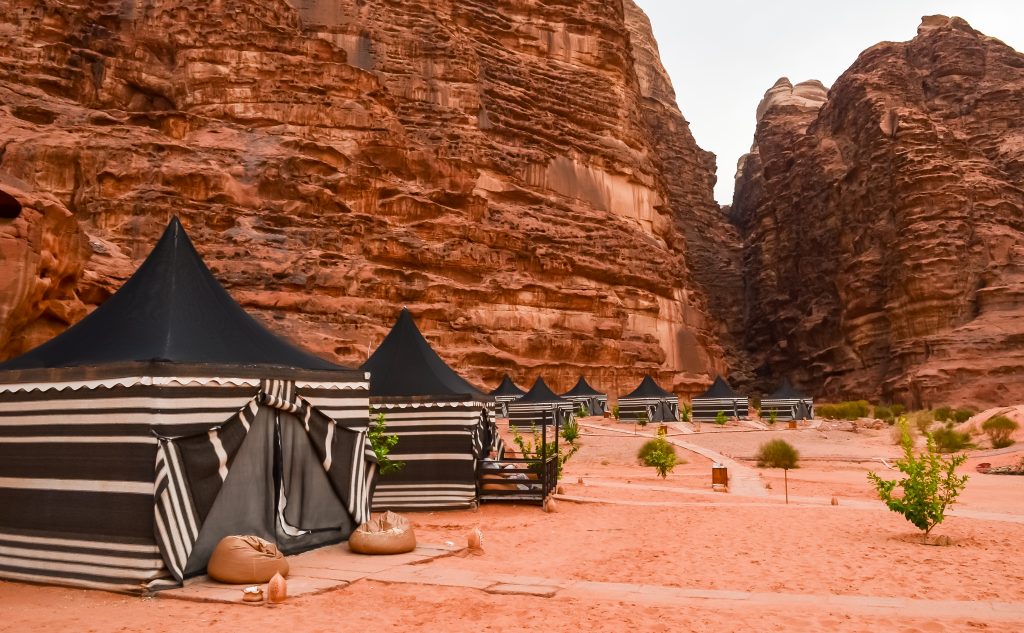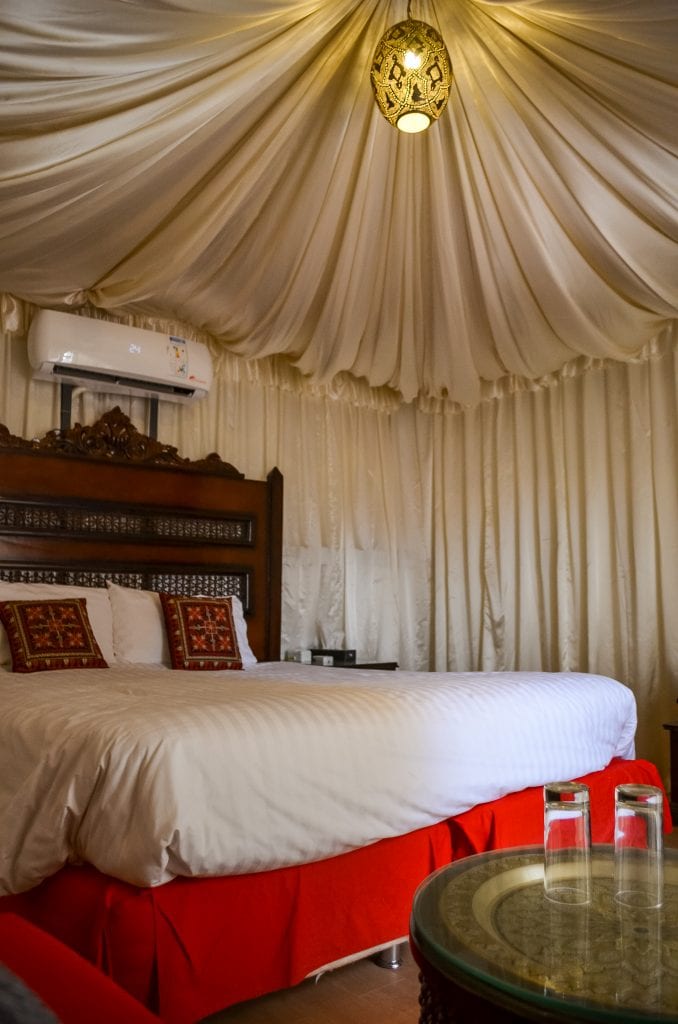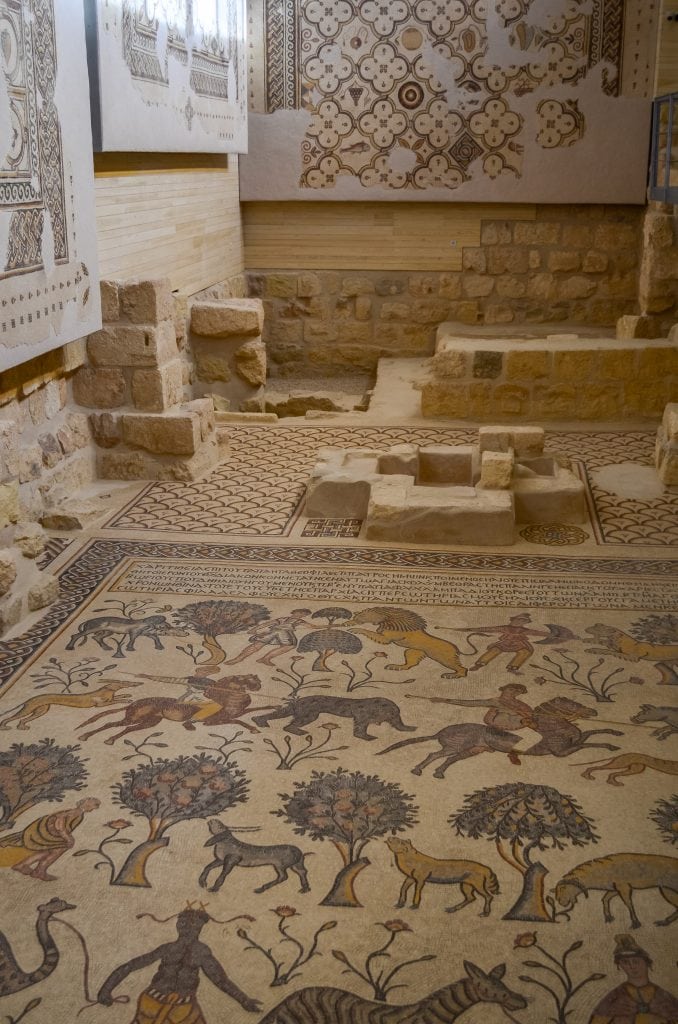Last Updated on 03/22/21 by Rose Palmer
A ten day trip to Jordan and Israel was definitely not going to be enough time to see all that these two history rich countries had to offer, but that was all the time we had. So I prioritized what I wanted to see and built my itinerary around this, adding in time to get from one place to another.
Day 0 – fly to Israel
- Day 1 – Arrive at Tel Aviv’s airport; take prearranged transportation to hotel in Jerusalem
- Day 2 – Tour Jerusalem
- Day 3 – Take pre arranged transportation to Tel Aviv; explore Old Jaffa quarter in Tel Aviv
- Day 4 – Day trip from Tel Aviv to Masada and the Dead Sea
- Day 5 – Fly from Tel Aviv to Eilat; cross the border and take a cab to hotel in Aqaba
- Day 6 – Beach time in Aqaba
- Day 7 – Drive to Wadi Rum and spend day and night in the desert
- Day 8 – Drive to Petra
- Day 9 – Explore Petra
- Day 10 – Scenic drive back to Tel Aviv via the Allenby/King Hussein Bridge crossing
- Day 11 – fly home

Visa Requirements and Crossing between Israel and Jordan
As I researched transportation options to get from Israel to Jordan and back again, I quickly realized that this would be the biggest hurdle in my plans. Entry into Israel from Jordan is easy and offered no issues, but leaving Israel and entering Jordan had some limitations.
There is no visa fee to enter Israel. However, you need to be aware that some Arab countries may not allow entry with an Israeli stamp in your passport. You need to get the stamp on a separate piece of paper which you then keep in your passport while in Israel (this is standard practice when you arrive at Ben Gurion Airport outside Tel Aviv).
Jordan charges a fee for a tourist visa to enter the country. For most visitors, including those from the USA, Canada, Europe and Australia, the visa can be obtained when landing at the airport in Amman. (See the Jordan visa requirements for each country here).
Depending on what you are planning to see in Jordan, consider getting the Jordan Pass which waives the visa fee and also includes prepaid entry into all of Joran’s most popular sights. The visa fee is waived as long as you spend 3 nights/4 days in Jordan. The Jordan Pass needs to be purchased before leaving home and needs to be printed.
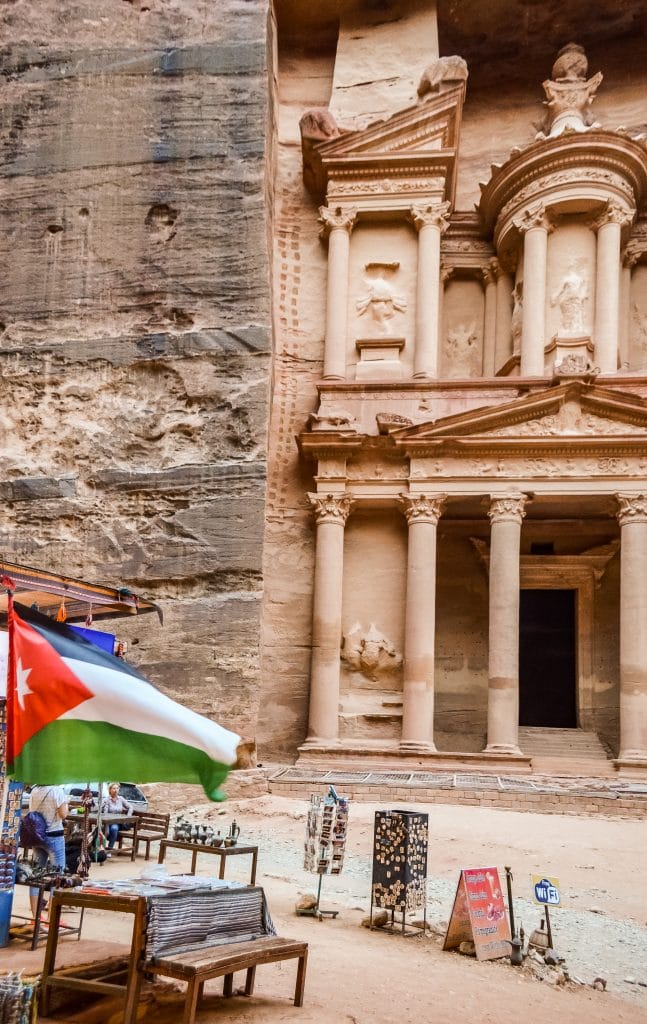
There are three different versions of the Jordan Pass depending on how many consecutive days you are planning in Petra. We had two days planned so we got the Jordan Explorer pass. (There is a one day version and a three day version).
However, the Jordan Pass is not a visa – it only waives the visa fee. You still need to get the visa stamp when arriving at the airport in Amman or at one of the land border crossings with Israel (but make sure to show your Jordan Pass so that you do not get charged).
There are three land border crossings between Israel and Jordan (note that you will have to pay an Israeli exit fee when you cross by land):
- The northern Jordan River/Sheikh Hussein crossing which is closest to Nazareth and Haifa in Israel
- The central Allenby/King Hussein Bridge which is the closest to Amman in Jordan and the cities of Jerusalem and Tel Aviv in Israel
- The southern Yitzhak Rabin/Wadi Araba crossing in between the towns of Eilat in Israel and Aqaba in Jordan, which is the closest crossing for Wadi Rum and Petra in Jordan.
Currently with the Jordan Pass, you can get a visa entry stamp at the Sheikh Hussein and the Wadi Araba crossing only, but NOT at the Allenby/King Hussein bridge so you need to take that into account if you are planning on entering Jordan by land from Israel. If you are planning on crossing at the Allenby/King Hussein you will need to get a visa from your local Jordanian embassy.
You should always check and confirm the latest Jordan tourism information and entry requirements before leaving home. Also, make sure to take into account any Jewish or Muslim holidays (like Yom Kippur or the Muslim New Year) and their impact on accessing the border crossings.
With a lot of planning and forethought it was possible to tour Israel and Jordan on our own and to cross the border on our own between the two counties.

For us, the best option was to spend a few days in Israel, Fly from Tel Aviv to Eialat, cross the border to Aqaba and then work our way north and cross back into Israel at the Allenby/King Hussein Bridge.
Getting around Israel and Jordan
We did not want to have to worry about the hassle of driving ourselves in either country, plus you cannot take a rental car across the border. We did not have the time to deal with public transportation options, so the best option was to get someone else to drive us.
In Israel I prebooked airport and hotel transfers on Viator.com and it all worked out fine. From all I had read, it seemed that in Jordan you could easily get around the country with taxis, so I planned for us to find transfers once we were at each accommodation.
My 10 day Israel and Jordan Itinerary
Our trip was in late November, scheduled around the US Thanksgiving holiday. I think this was the best time to visit Jordan because temperatures were comfortable in both countries and since it was considered shoulder season, the major sights like Jerusalem and Petra were not very crowded.
Day 0 – Leave the USA
Most flights from the USA to Israel connect somewhere in Europe though there are a few non-stop options from major hubs like New York, Los Angeles and Miami. We had an overnight flight with a connection in Munich.
Day 1 – Arrive in Tel Aviv and transfer to Jerusalem
Our layover in Munich allowed us to stretch our legs and get a nice and leisurely breakfast and lots of coffee. Not surprising, security to get onto the flight to Tel Aviv was very tight. (I had a tiny pair of scissors in my carry on bag which I always travel with and I had to leave it at security). We finally arrived at Tel Aviv’s Ben Gurion airport mid afternoon local time, though with the 7 hour time difference, our bodies thought it was still morning.
Our pre arranged pick up and transportation was waiting for us once we passed through customs and took us from the airport to our hotel in Jerusalem . It was about a one hour drive to get to our Jerusalem hotel. In mid November the sun set around 4:40 PM so we only had a little bit of light to see the scenery on the way.
I chose the Sephardic House Hotel for our stay in Jerusalem because it was in the heart of the Jewish Quarter and gave us easy access to the main historic sights that I wanted to see. The hotel was quite comfortable with a nice mix of modern amenities combined with the traditional elegance befitting a 200 year old building.
We took a little time to explore the Jewish Quarter around the hotel and picked up a quick bite before crashing after our long travel day.
Day 2 – Tour Jerusalem
We had only one full day in Jerusalem so we wanted to make the most of it. We started early in the morning at the Dome of the Rock followed by a stop at the Western Wall.
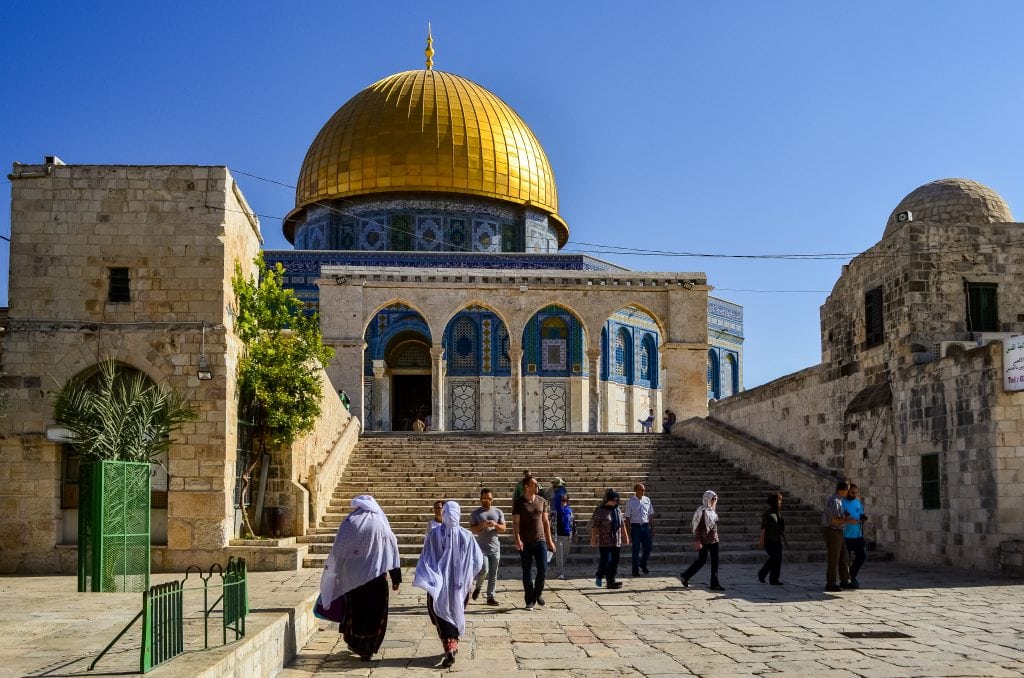
To get the most of our day we also took two Sandemans tours, the free two hour Introduction to Jerusalem tour and the Mount of Olives Tour. This was a very efficient and instructive way to get to see the most of this historic city.
We finished the day with a stop at the Church of the Holy Sepulcher.
You can read all the details in my post One Day in Jerusalem: Where Three Religions Intersect.
Day 3 – Transfer from Jerusalem to Tel Aviv; explore Old Jaffa in Tel Aviv
Since we were up early, we strolled around Old Jerusalem for a bit again, including another visit to the Dome of the Rock. Read about my Tips For Visiting the Dome of the Rock and Temple Mount in Jerusalem post to learn the best way to see this beautiful UNESCO listed sight on your own.
Once again I had set up for a driver to pick us up and take us from Jerusalem to Tel Aviv. We checked into the DAN Hotel Tel Aviv which was perfectly situated on Tel Aviv’s long beachfront. After grabbing a quick late lunch we chose to walk the 40 minutes to the old city of Jaffa.
Tel Aviv has developed their waterfront into a beautiful multi use area with a wide walking path that skirted the beach for much of our walk. It was a pleasure to stroll to our destination with a warm Mediterranean breeze in our face and the sound of the waves hitting the shore. Unfortunately we arrived a little too late for the Sandemans free Tel Aviv Old Jaffa tour which we had hoped to take, so we just explored on our own.
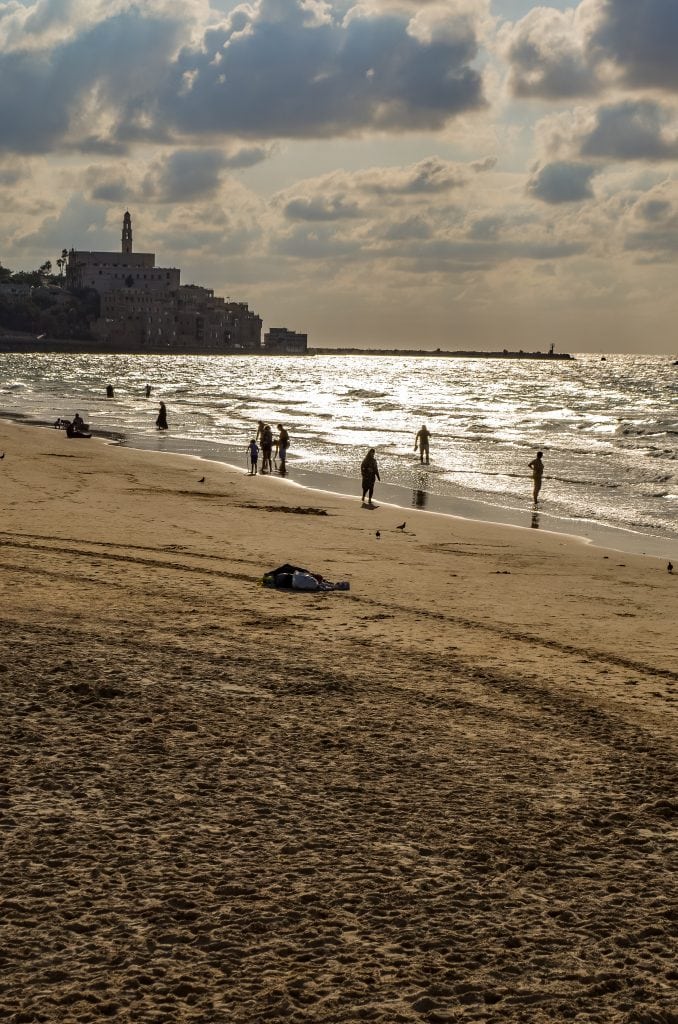
Jaffa has been a port town for almost 4000 years. Throughout the centuries Egyptians, Greeks, Romans, Crusaders, Ottomans and Europeans have trodden its narrow alleys and left their mark on its history.
In the 1960’s the area was rebuilt and its historic roots restored while at the same time being modernized so that today the old narrow lanes are filled with galleries, artists studios, cafes, and restaurants. It’s a popular destination for locals and tourists alike and it was fun to explore.
The walk back to the hotel along the beach was just as pleasant, especially with a stunning sunset to keep us company.

Day 4 – Day trip from Tel Aviv to Masada and the Dead Sea
While in Israel, I really wanted to see the UNESCO World Heritage site of Masada as well as the Dead Sea. I booked a guided day tour on Viator.com to both destinations which also offered hotel pick up and drop off.
The two hour drive took us through the Palestinian Territory as we passed into the dry, desert region of Israel. At Masada our guide gave us an enthusiastic tour of the site and all of its fascinating history.

King Herod built Masada high on an isolated plateau in 31 BCE as a retreat to escape to. Despite being in the desert, his engineers built a sophisticated catch and transport system that captured and stored rainwater. The views from the top of Masada go on for miles and take in much of the nearby Dead Sea.
From Masada we went to the Dead Sea to swim in the lowest elevation lake on earth. The hypersaline water here has been used as a resort since the time of King Herod. Our guide took us to one of the public beaches where we had a chance to change and then experience the floating properties of this highly salty body of water.

You can read all the details about this day trip on my post A Day Trip from Tel Aviv – Take A Tour to Masada and the Dead Sea.
Day 5 – Fly from Tel Aviv to Eilat; cross the border and take a cab to hotel in Aqaba
We started the day with an 8 AM flight from Tel Aviv to the southern coastal town of Eilat which I had booked through Orbitz. It was a quick one hour flight, though with the tight security at the airport, we still made it a point to get there two hours early.
Once we landed in Eilat we took a taxi from the airport to the border crossing. After getting through the Israel crossing terminal and paying our fees it was a short walk to the Jordanian entry terminal. At that early hour of the morning, we were the only ones passing through the border.
Before leaving the US, I went through the effort to also get Jordanian visas from the embassy in Washington DC just to be sure that we were covered. Unfortunately, already having a visa as well as a Jordan Pass caused some confusion with the border agents since they were used to seeing just one or the other. After seeing three different agents, they finally agreed to let us pass through.
Once we exited the gate at the Jordanian border terminal, we took one of the waiting taxis to our hotel. Mohammed, the taxi driver was extremely pleasant and congenial, and we ended up using him to drive us around Jordan to our other destinations.
Aqaba has some big name brand resorts with beach front property like Kempinski, Movenpick and Intercontinental. I decided on the Intercontinental for its large private beach and its great restaurant options. and it did not disappoint.
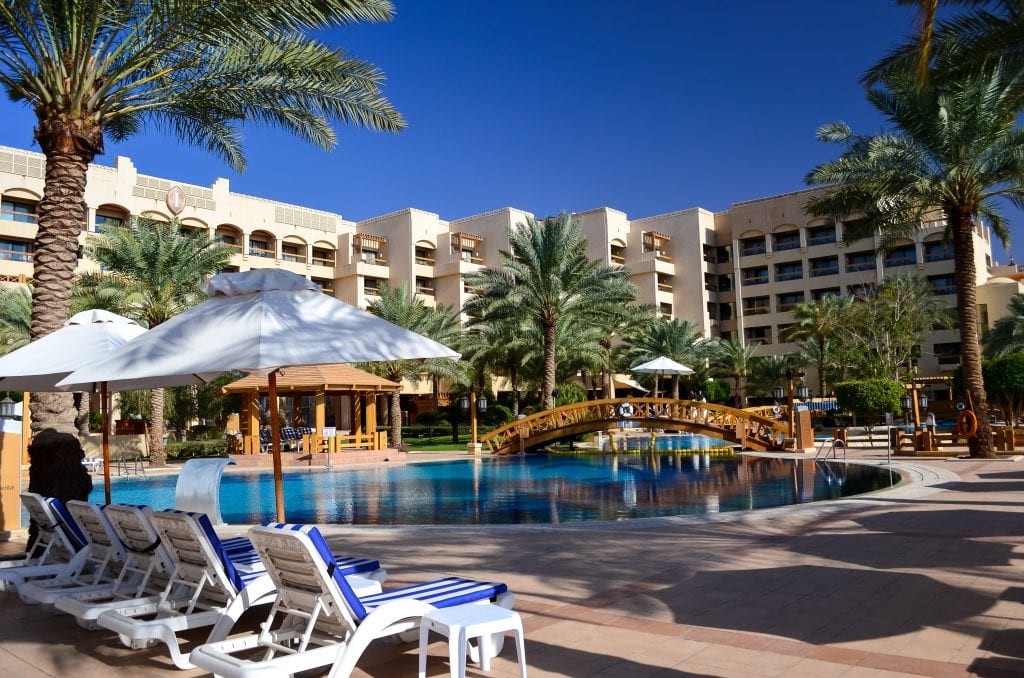
Day 6 – Beach time in Aqaba
Our primary reason for stopping in Aqaba was so that my husband could spend some time diving in the Red Sea. The Red Sea is supposed to have some of the best diving sites in the world. He chose to dive with the Aqaba International Dive Center because of its good ratings.
The dive shop was a short walk from our hotel and after getting outfitted we were driven to Japanese Garden Dive site. The beauty of diving in this part of Jordan is that there are many great diving sites that are easily accessible from the shore.

Even though my husband was PADI certified, he had not been scuba diving for very many years. His scuba instructor gave him the one on one attention he needed to feel comfortable under water again. He got in two dives with a lunch break in between. He was thrilled with his diving experience and kept saying that it was like swimming in an aquarium.
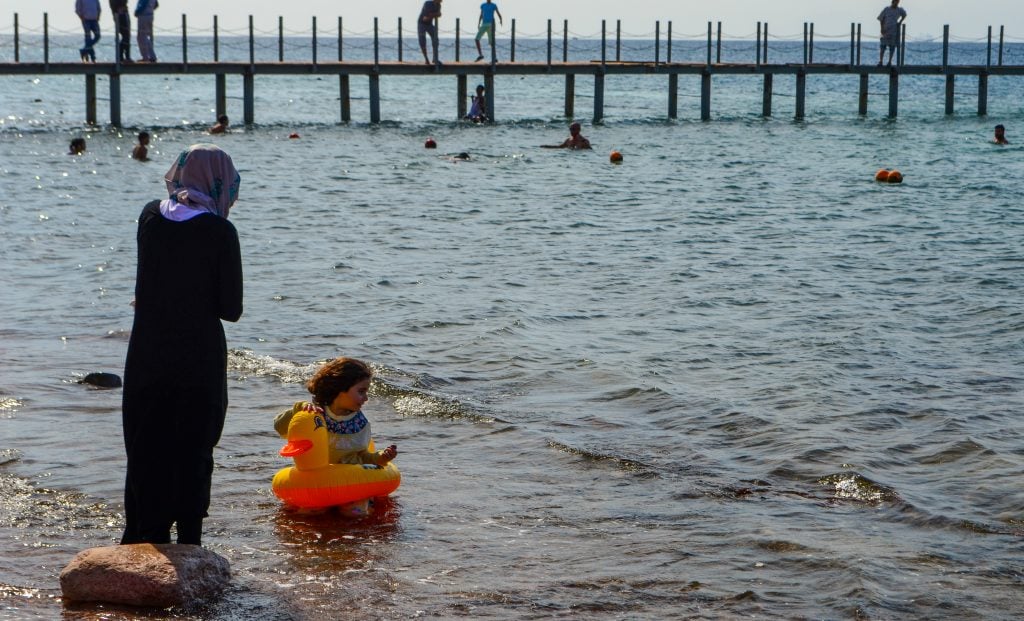
While my husband was diving, I relaxed on the beach and tried some snorkeling but the reef close to shore was not that colorful. In hindsight, I think I should have stayed at the resort and enjoyed the facilities there instead. We did get to spend time later in the day taking advantage of all that the Intercontinental had to offer.
Day 7 – Drive to Wadi Rum and spend a day and night in the desert
From Aqaba, our driver took us to the Wadi Rum Rest House where we met our guide from the Wadi Rum Night Luxury Camp where we were spending the night. The Wadi Rum desert is another one of Jordan’s UNESCO listed heritage sites which protects 12,000 years of petroglyphs and other rock art.
Along with our overnight accommodations, I also booked the optional camel ride through the desert and a 4×4 tour of Wadi Rum. We started with the camel ride which took us from Wadi Rum Village to Lawrence’s Spring. This was my first time riding a camel and while it was not particularly comfortable, the desert of Wadi Rum certainly was the right atmosphere for such a memorable first experience.
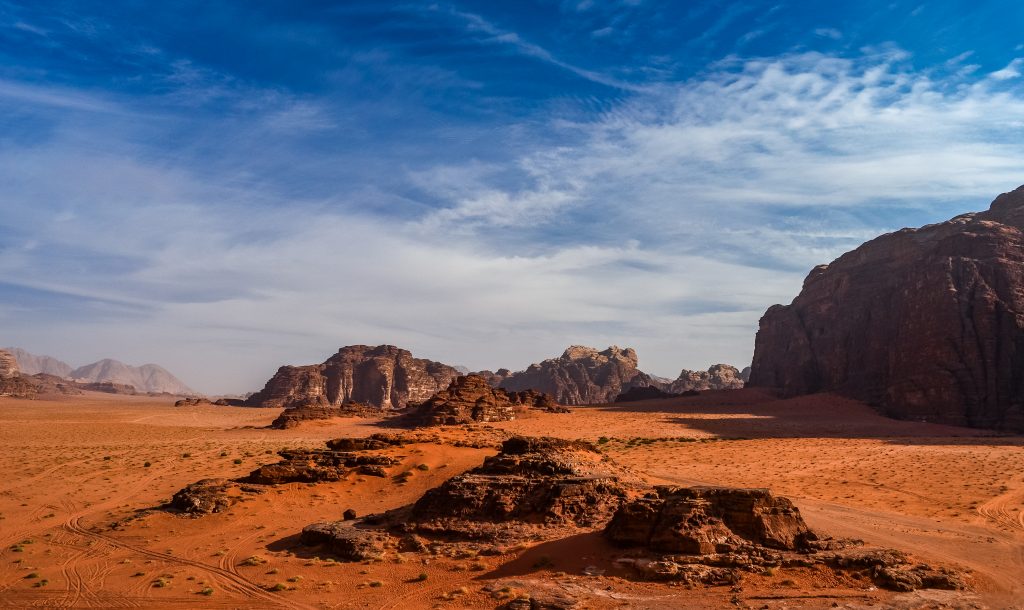
This part of Jordan was made famous by the author T.E. Lawrence of “Lawrence of Arabia” fame and Lawrence’s Spring was named after him. As a British colonel he played a big role in the Arab Revolt against the Ottomans during World War I.
After our Camel ride, we transferred seats to the back of a pickup truck for the rest of the afternoon to see the sights in Wadi Rum. While the seats here were more padded, the ride was not necessarily more comfortable as the truck bounced across the sand.
The Wadi Rum desert was indeed a beautiful natural sight to see. Wide reddish tinted swatches of fine sand were ringed by huge reddish tan rocks formations that had been wind carved over the millennia into rugged and jagged shapes.
The afternoon ended by watching the sun set over the desert from one of the many rock outcroppings. Afterwards we headed to our glamping site and our luxuriously appointed tent and home made Jordanian dinner.
For more details about our Wadi Rum experience you can also read my post Desert magic at a Wadi Rum Luxury Camp in Jordan.
Day 8 – Drive to Petra and explore Petra
After another bumpy drive through the early morning desert back to Wadi Rum village, our driver took us the two hours to Jordan’s premier archeological site, Petra. We checked in to the Movenpick Resort Petra which I picked because it is conveniently located across the street from the Petra Visitor’s Center.
Our Jordan Explorer Pass covered our two days of sightseeing in Petra, so after a quick lunch we headed straight into Jordan’s most famous sight. It was about a 30-40 minute walk through the Siq to the Treasury, Petra’s signature ancient structure.

From the Treasury we continued through the heart of Petra, and spent the rest of the afternoon exploring the Street of Facades, the theater and the Royal Tombs. Petra was the capitol city of the Nabateans, a wealthy merchant culture that existed about 2000 years ago. This city was the heart of their trading empire which extended as far as India to the East and Greece and Egypt to the west.

Day 9 – Explore Petra
We spent our second day in Petra exploring it in more detail. We started early and beat the crowds and the tour groups as we walked through the Siq again. To get a different perspective on the Treasury we took the hike to the high view of the Treasury and reached the top in time to see the Treasury totally lit by the morning sun.

Besides Nabatean ruins, there are also remains from Byzantine churches that were built in the 4th century. Intricate mosaics have been excavated and are now displayed under a large protective roof.
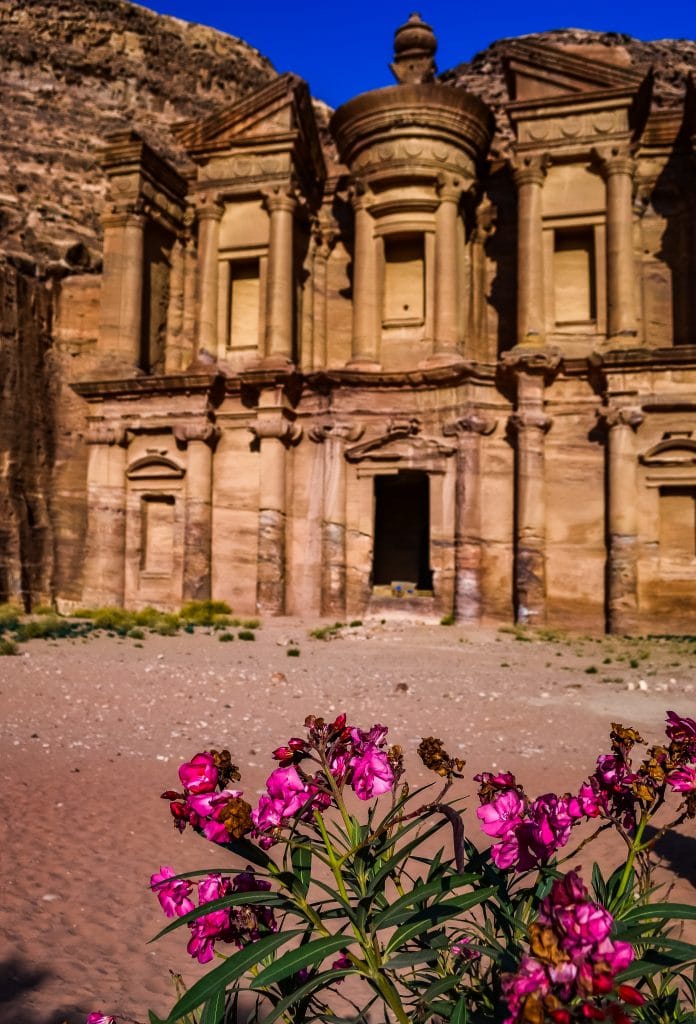
For the afternoon we tackled the long uphill hike to Petra’s most advanced structure, the Monastery. The hike takes 40-60 minutes and includes 800 steps but is well worth the effort. The afternoon sun makes the Monastery glow like gold and we enjoyed the view with a snack and a drink at a Bedouin run café.
We ended the day with the Petra by Night event which is held every Monday, Wednesday and Thursday night (this is an extra fee and is not covered by the Jordan Pass). It’s a very well attended activity but even with the crowds, seeing the Siq and the Treasury lit up by hundreds upon hundreds of candles was special.

My posts Inside Petra by Night and Day and 13 Petra Photography Tips provide lots of detailed information about our 2 days in Petra.
Day 10 – Scenic drive back to Tel Aviv via the Allenby/King Hussein border crossing
This day did not go quite as planned for us – one of the very few times where my well laid travel plans did not work out. Before leaving home I had prebooked for a driver/guide to pick us up and drive us to the Allenby/King Hussein border crossing while doing some sightseeing along the way.
Our tour driver did not show up at our hotel at the scheduled time. When he still had not arrived an hour later despite numerous phone calls to the tour company, we had the hotel concierge at the Movenpick set us up with a driver/guide for the day. Unfortunately this meant we left two hours later than I wanted to and had to cut short some of my hoped for touring.
Without stopping, it’s about a 4 hour drive from Petra to the central border crossing which gave us a couple of additional hours for stops. After the first two hours of driving, we made a short detour to view the great Kerak Castle.

This crusader castle was built in the early 12th century on top of what were once Nabatean and Roman structures. Because of its critical location on the trade route connecting Syria to Egypt and Mecca, Kerak Castle had a tumultuous history as different leaders attempted to take control.
Kerak Castle is a popular tourist sight, but unfortunately, we only had time to see it from afar before we had to move on. Two hours later we were in the town of Madaba to visit St. George’s Greek Orthodox Church.
St. George’s church is famous for a Byzantine mosaic map depicting the Middle East as it looked in the 6th century. The church building is fairly recent having been built a little over 100yers ago, but it protects this unique, ancient mosaic that was discovered during construction.
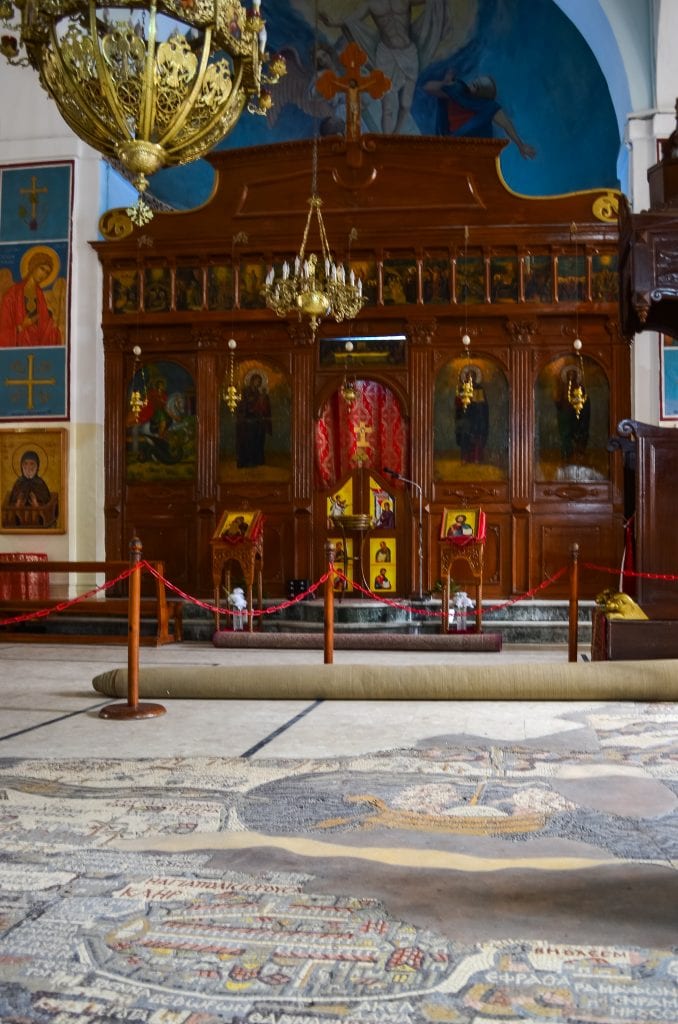
The original map was incredibly large, but what still remains today is still fairly impressive. It measures about 50 feet by 15 feet and is made up of a few million little pieces of stone tiles which clearly depict the world as it was known fifteen hundred years ago.
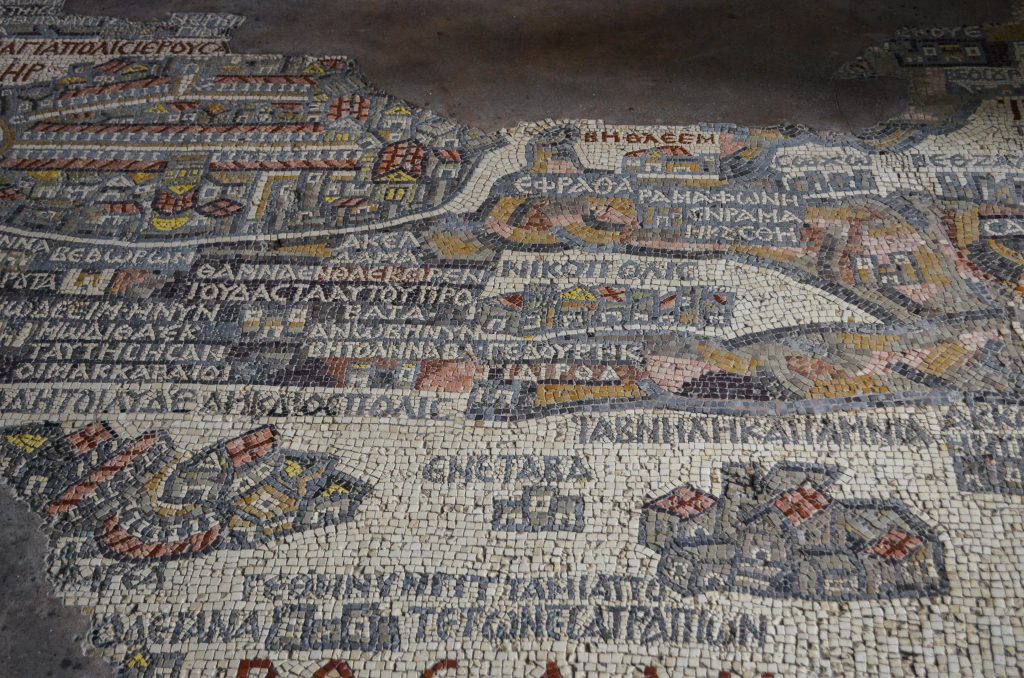
An additional 20 minute drive took us to the Mt. Nebo overlook. According to the Old Testament, Mount Nebo is where Moses finally saw the promised land though he never actually got there. It is also supposed to be the location where he is buried.
At 2000 feet above the valley floor, the view from the top was indeed expansive taking in the Dead Sea and Jerusalem on the distant horizon. If this was his view of the promised land, hopefully it was a little greener in Moses’s day.

Though the church has been rebuilt and is quite simple and modern, it preserves a large number of intricate mosaics from the 6th century basilica that once stood on this spot. When Pope John Paul II visited here in 2000, he planted an olive tree representing peace.
Our final stop in Jordan was the Tourist Terminal at the King Hussein border crossing. (If you have to pay any exit fees this is where you will pay them). With our Jordan Pass and the fact that we spent 5 nights in Jordan, we did not need to pay anything additional at the time.
Jordanian passport control kept our passports until we boarded the shuttle bus that takes you to the Israeli Terminal 3 miles away. We had to pay for a ticket for the bus, and once we were on the bus, we were given our passports back. When the bus had enough people on it, it left for the Israeli side.
At the Israeli Terminal, we dropped off our large luggage at a curbside counter and then had our passports checked at another outside counter. Inside the building, our passports were checked again and then we went to the immigration kiosk where the agent asked us some questions (ie: what was your mother’s grandmother’s maiden name? – really?)
After a few minutes with the immigration officer we went through and had our passports checked yet again, and then picked up our luggage which presumably had been screened and was safe for further travel through Israel. Fortunately, it was not that busy so the whole border crossing process took us about an hour. I can see it taking significantly longer on a very busy day.
Once we were outside the terminal building we took a bus into Jerusalem where we then negotiated with a taxi drivers to take us the 1 hour drive to our hotel near the Tel Aviv airport.
With all the driving we had to do on this day and the hassles of the border crossing, this was my least favorite day of the trip. Our Jordanian driver was great and was also a fantastic guide, providing a lot of information about the sights we stopped at and also about life in Jordan, but it all felt rushed.
Had we had the time, I would have added another day or two or three in Jordan to work our way north before crossing back to Israel. I would have liked to also have seen the Dana Biosphere Reserve (another UNESCO site), stayed at a resort on the Dead Sea and seen the well preserved Roman ruins at Jerash – next time I hope.
Day 11 – fly home
Our flight home left Tel Aviv at a very early 6:15 AM. On the way back we had a connection in Madrid, one of my favorite airports in Europe from an architectural standpoint. By 4 PM local time we were back in the US, ready to get home and get some much needed sleep.
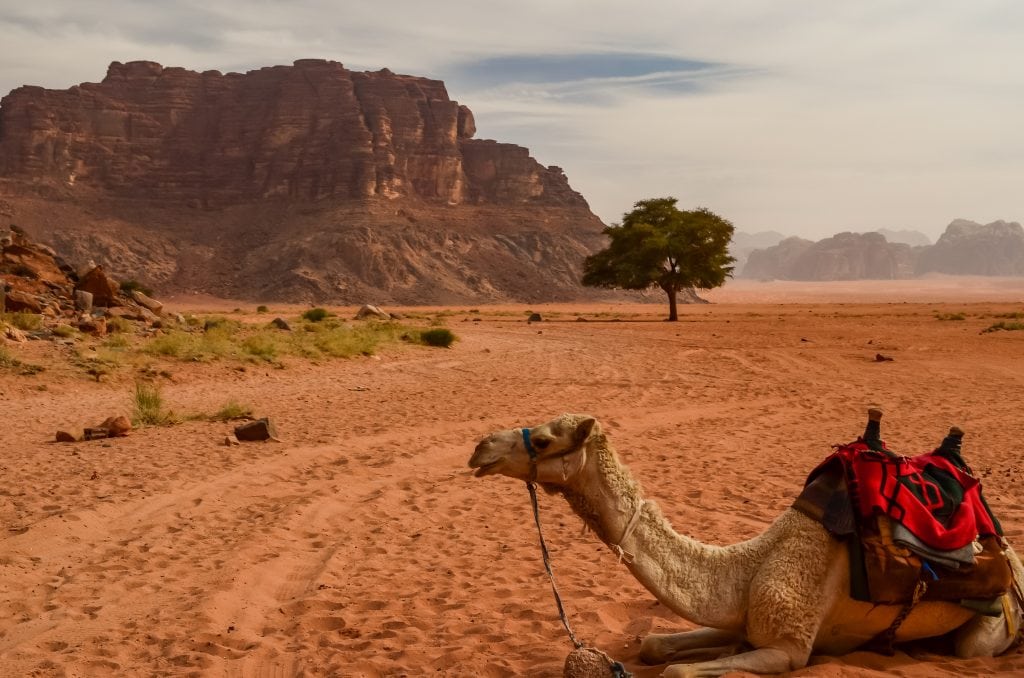
Tips for independent travel to Israel and Jordan
- The benefits of traveling independently are that you can do and see all the best place to visit in Jordan at your own pace and on your personal schedule, but it requires a lot of up front research, especially as it applies to the visa and entry requirements which can be confusing for this part of the world. Do your research for the most recent information regarding transferring between these two countries. Get information from official government websites and from the most recent traveler reviews. Be wary of websites that have old and outdated information.
- Take plenty of cash in US currency and then also converted to the local currency. You will need it for taxi drivers, tips, snacks, drinks, and potentially for attraction entry fees and country exit/entry fees. I always keep my cash in a money belt when I travel.
- Be flexible, patient and polite at the border crossings. Answer the questions asked but don’t necessarily offer up any additional information.
- Don’t have your passport stamped with an Israeli visa if you think you will be traveling to an Arab country at some point – get the stamp on a piece of paper and keep it in your passport for the duration of your trip.
- Security for flights into Israel and at the border crossings into Israel is serious business. Give yourself plenty of time and stay patient.
- If you are not comfortable waiting to find transportation when you get to Israel or Jordan to get around, contact your hotel to have them set you up with a driver. Good quality hotels can help you with dependable transportation.
- Having two days in Petra was definitely worth the time. The archeological site is large and it’s nice to be able to enjoy all the accessible areas without rushing.
I hope that by sharing our Israel and Jordan travel experiences you find them helpful for planning your own itinerary to this incredibly diverse and historic part of the Middle East.
Thanks for visiting
Rose
Pin this!







